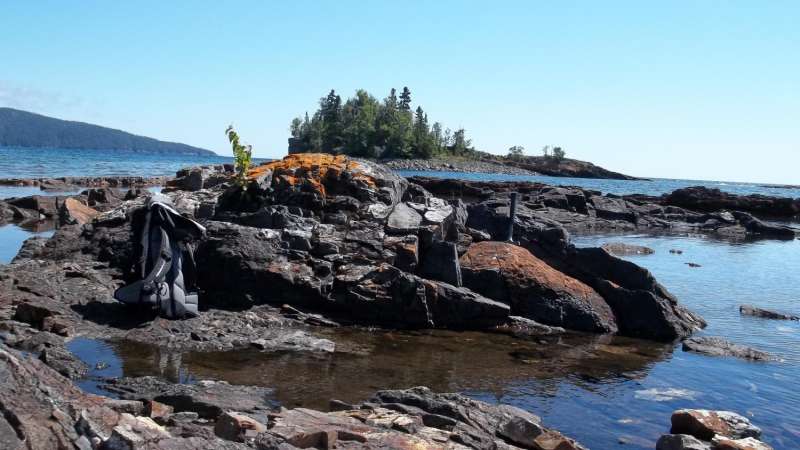January 17, 2017 report
Rock samples suggest oxygen levels during 'Lomagundi Event' were high enough to support life development progress

(Phys.org)—A small team of researchers in the U.S. has found evidence in rock samples that suggests that oxygen levels during the Lomagundi Event were high enough to support the advancement of life on Earth. In their paper published in Proceedings of the National Academy of Sciences, the team describes how they analyzed rocks that had formed during the event period and in so doing found evidence of higher than expected oxygen levels.
Scientists believe that life first emerged on planet Earth almost 4 billion years ago—but it took almost another 3 billion years for eukaryotes (a cell-based organism with genetic material) to come about. But there is also evidence that the Earth experienced a time when oxygen levels rose, called the Lomagundi Event—it occurred approximately 2.3 to 2.1 billion years ago. Scientists would like to know whether the degree of oxygen enrichment during that time period was enough to support higher life form development, and if so, why eukaryotes didn't arise during that time instead of a billion years later.
To find out how much oxygen was in the atmosphere during the Lomagundi Event, the researchers collected rocks that had formed on the ocean floor during this period and ran tests that showed how much selenium they contained—it is released when rocks on land erode in the presence of oxygen and are carried to the sea by rivers, where selenium builds up in sea bottom rocks. Once on the sea bottom (in shallow areas), two selenium isotopes, 78 and 82 are metabolized by microbes and the ratios of each are determined by how much oxygen is in the water. Using all this information, the researchers were able to calculate that there would have been approximately 5 micromoles per liter of oxygen in the water during the Lomagundi Event—enough, they suggest, to support the development of life into something more complex.
To date, there has been little evidence that such a development occurred, but of course, as the researchers note, that doesn't mean it didn't happen. It is possible that life got a start then, was set back as atmospheric oxygen levels mysteriously dropped, and left behind little to show it had been there.
More information: Selenium isotopes record extensive marine suboxia during the Great Oxidation Event, PNAS, www.pnas.org/cgi/doi/10.1073/pnas.1615867114
Abstract
It has been proposed that an "oxygen overshoot" occurred during the early Paleoproterozoic Great Oxidation Event (GOE) in association with the extreme positive carbon isotopic excursion known as the Lomagundi Event. Moreover, it has also been suggested that environmental oxygen levels then crashed to very low levels during the subsequent extremely negative Shunga–Francevillian carbon isotopic anomaly. These redox fluctuations could have profoundly influenced the course of eukaryotic evolution, as eukaryotes have several metabolic processes that are obligately aerobic. Here we investigate the magnitude of these proposed oxygen perturbations using selenium (Se) geochemistry, which is sensitive to redox transitions across suboxic conditions. We find that δ82/78Se values in offshore shales show a positive excursion from 2.32 Ga until 2.1 Ga (mean +1.03 ± 0.67‰). Selenium abundances and Se/TOC (total organic carbon) ratios similarly show a peak during this interval. Together these data suggest that during the GOE there was pervasive suboxia in near-shore environments, allowing nonquantitative Se reduction to drive the residual Se oxyanions isotopically heavy. This implies O2 levels of >0.4 μM in these settings. Unlike in the late Neoproterozoic and Phanerozoic, when negative δ82/78Se values are observed in offshore environments, only a single formation, evidently the shallowest, shows evidence of negative δ82/78Se. This suggests that there was no upwelling of Se oxyanions from an oxic deep-ocean reservoir, which is consistent with previous estimates that the deep ocean remained anoxic throughout the GOE. The abrupt decline in δ82/78Se and Se/TOC values during the subsequent Shunga–Francevillian anomaly indicates a widespread decrease in surface oxygenation.
Journal information: Proceedings of the National Academy of Sciences
© 2017 Phys.org




















